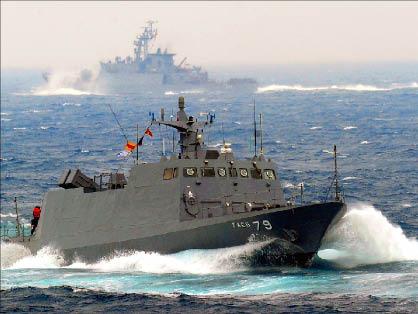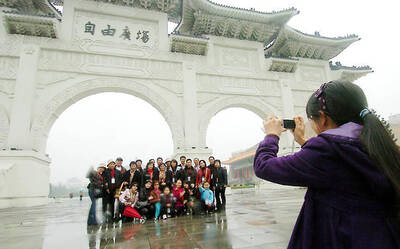The Ministry of National Defense yesterday refused to comment on a report in the Chinese Communist Party-run Guangming Daily saying that the Kuang Hua VI (KH-6) fast attack missile boats that have been in service in the Taiwanese navy since 2010 were plagued by deficiencies and were a “fantasy.”
Taiwan commissioned its first squadron of 11 KH-6 radar-evading fast-attack craft, produced by China Shipbuilding Corp, in May 2010. Since then, 20 more of the 170-tonne boats have entered service, the most recent 10 on Dec. 2 last year at Tsuoying Naval Base in Greater Kaohsiung.
The 31 boats comprise the navy’s three squadrons, which have been dubbed Hai Chiao (Sea Sharks).

Photo: Chang Chung-i, Taipei Times
Each boat, which costs about US$12.3 million, comes equipped with four Hsiung Feng II anti-ship missiles with a range of 150km, as well as a 20mm anti-aircraft gun, a 7.62mm machine gun and decoy systems.
The KH-6s, which have gradually been replacing the Navy’s Israeli-made Hai Ou (Sea Gull)-class missile patrol boats, are integral to the defense of Taiwan’s waters. Given the narrowness of the Taiwan Strait, the boats would be able to attack targets at naval bases along China’s coast.
Some naval experts, including James Holmes of the US Naval War College, have hailed the capabilities of fast-attack craft as a potentially efficient asymmetrical counter to the growing Chinese military.
The Hsiung Feng III, currently under development by the Chung Shan Institute of Science and Technology, is also a main component of Taiwan’s emerging sea defenses.
However, the Guangming Daily on Tuesday claimed that the program was beset with problems and called the Sea Sharks a “fantasy.” At issue, the paper said, was the fact that the guns on the KH-6 needed to be operated manually, which undermined the craft’s “stealth” capability.
The article also said the craft was ill-suited for the rough weather conditions in the Taiwan Strait, pointing to an incident involving a prototype that lost power and became stranded on an outer seawall during Typhoon Jangmi in September 2008.
In all, the paper said, those deficiencies imposed “several restrictions” on the boats’ use.
Contacted by the Taipei Times yesterday, Ministry of National Defense spokesperson Colonel David Lo (羅紹和) said the ministry would not comment on Chinese media reports on Taiwan’s weapons systems.
Asked for comment, Holmes said the navy probably had corrected any deficiencies that lend themselves to easy fixes, such as clutter on the main deck.
“The point about handling well in heavy weather or at sea, however, is not something so easily corrected,” he said via e-mail. “The vessel is top-heavy because of its tall superstructure, which raises its ‘center of buoyancy’ and makes it bob around like a cork in high seas. That compromises its ability to go to sea and fight in all weather.”
“Improving the KH-6’s seakeeping ability would require a major redesign to lower weight within the vessel. That’s not something so easily solved,” Holmes said.
“Calling the craft a ‘fantasy’ overstates things in my view, so our Chinese friends could be indulging in some triumphalism. But I certainly see the KH-6 as only a transitional platform until something better is in the water,” he added.
Wendell Minnick, the Taipei-based Asia bureau chief for Defense News, said the deficiencies mentioned in the article were old ones and that he suspected the navy had ironed most of them out by now.
“The KH-6 missile patrol boat program has experienced developmental problems. One main problem is balancing the weight of larger missiles across the frame,” Minnick told the Taipei Times yesterday. “This has caused some problems in the past, but they appear to be seaworthy at present.”
“For the most part, Taiwan does produce, at the end of the day, impressive weapon systems and in many ways the Taiwanese are some of the best weapons producers in the world,” he said.

NUMBERS IMBALANCE: More than 4 million Taiwanese have visited China this year, while only about half a million Chinese have visited here Beijing has yet to respond to Taiwan’s requests for negotiation over matters related to the recovery of cross-strait tourism, the Tourism Administration said yesterday. Taiwan’s tourism authority issued the statement after Chinese-language daily the China Times reported yesterday that the government’s policy of banning group tours to China does not stop Taiwanese from visiting the country. As of October, more than 4.2 million had traveled to China this year, exceeding last year. Beijing estimated the number of Taiwanese tourists in China could reach 4.5 million this year. By contrast, only 500,000 Chinese tourists are expected in Taiwan, the report said. The report

SHIPS, TRAINS AND AUTOMOBILES: The ministry has announced changes to varied transportation industries taking effect soon, with a number of effects for passengers Beginning next month, the post office is canceling signature upon delivery and written inquiry services for international registered small packets in accordance with the new policy of the Universal Postal Union, the Ministry of Transportation and Communications said yesterday. The new policy does not apply to packets that are to be delivered to China, the ministry said. Senders of international registered small packets would receive a NT$10 rebate on postage if the packets are sent from Jan. 1 to March 31, it added. The ministry said that three other policies are also scheduled to take effect next month. International cruise ship operators

Temperatures are forecast to drop steadily as a continental cold air mass moves across Taiwan, with some areas also likely to see heavy rainfall, the Central Weather Administration (CWA) said. From today through early tomorrow, a cold air mass would keep temperatures low across central and northern Taiwan, and the eastern half of Taiwan proper, with isolated brief showers forecast along Keelung’s north coast, Taipei and New Taipei City’s mountainous areas and eastern Taiwan, it said. Lows of 11°C to 15°C are forecast in central and northern Taiwan, Yilan County, and the outlying Kinmen and Lienchiang (Matsu) counties, and 14°C to 17°C

STEERING FAILURE: The first boat of its class is experiencing teething issues as it readies for acceptance by the navy, according to a recent story about rudder failure The Hai Kun (海鯤), the nation’s first locally built submarine, allegedly suffered a total failure of stern hydraulic systems during the second round of sea acceptance trials on June 26, and sailors were forced to manually operate the X-rudder to turn the submarine and return to port, news Web site Mirror Daily reported yesterday. The report said that tugboats following the Hai Kun assisted the submarine in avoiding collisions with other ships due to the X-rudder malfunctioning. At the time of the report, the submarine had completed its trials and was scheduled to begin diving and surfacing tests in shallow areas. The X-rudder,